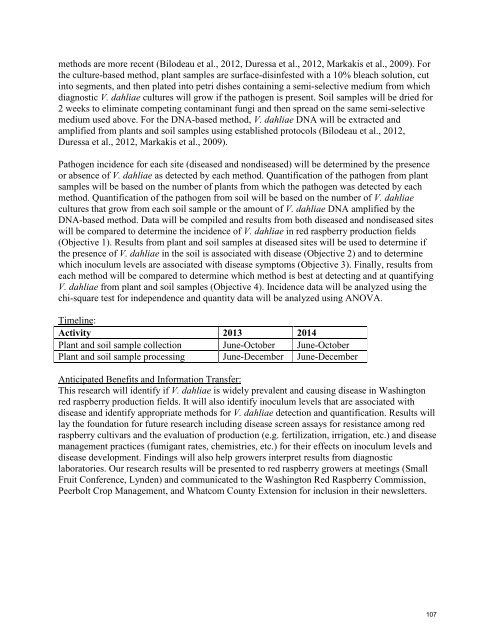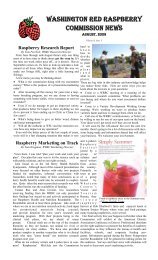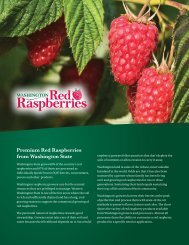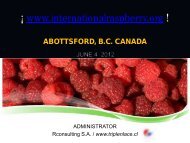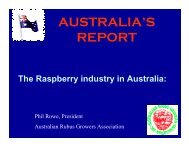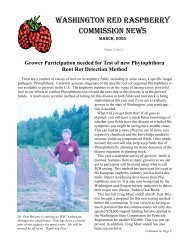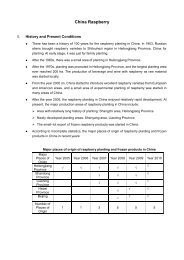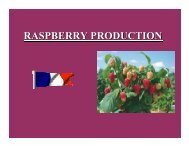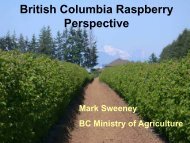2012 - Washington Red Raspberry Commission
2012 - Washington Red Raspberry Commission
2012 - Washington Red Raspberry Commission
Create successful ePaper yourself
Turn your PDF publications into a flip-book with our unique Google optimized e-Paper software.
methods are more recent (Bilodeau et al., <strong>2012</strong>, Duressa et al., <strong>2012</strong>, Markakis et al., 2009). For<br />
the culture-based method, plant samples are surface-disinfested with a 10% bleach solution, cut<br />
into segments, and then plated into petri dishes containing a semi-selective medium from which<br />
diagnostic V. dahliae cultures will grow if the pathogen is present. Soil samples will be dried for<br />
2 weeks to eliminate competing contaminant fungi and then spread on the same semi-selective<br />
medium used above. For the DNA-based method, V. dahliae DNA will be extracted and<br />
amplified from plants and soil samples using established protocols (Bilodeau et al., <strong>2012</strong>,<br />
Duressa et al., <strong>2012</strong>, Markakis et al., 2009).<br />
Pathogen incidence for each site (diseased and nondiseased) will be determined by the presence<br />
or absence of V. dahliae as detected by each method. Quantification of the pathogen from plant<br />
samples will be based on the number of plants from which the pathogen was detected by each<br />
method. Quantification of the pathogen from soil will be based on the number of V. dahliae<br />
cultures that grow from each soil sample or the amount of V. dahliae DNA amplified by the<br />
DNA-based method. Data will be compiled and results from both diseased and nondiseased sites<br />
will be compared to determine the incidence of V. dahliae in red raspberry production fields<br />
(Objective 1). Results from plant and soil samples at diseased sites will be used to determine if<br />
the presence of V. dahliae in the soil is associated with disease (Objective 2) and to determine<br />
which inoculum levels are associated with disease symptoms (Objective 3). Finally, results from<br />
each method will be compared to determine which method is best at detecting and at quantifying<br />
V. dahliae from plant and soil samples (Objective 4). Incidence data will be analyzed using the<br />
chi-square test for independence and quantity data will be analyzed using ANOVA.<br />
Timeline:<br />
Activity 2013 2014<br />
Plant and soil sample collection June-October June-October<br />
Plant and soil sample processing June-December June-December<br />
Anticipated Benefits and Information Transfer:<br />
This research will identify if V. dahliae is widely prevalent and causing disease in <strong>Washington</strong><br />
red raspberry production fields. It will also identify inoculum levels that are associated with<br />
disease and identify appropriate methods for V. dahliae detection and quantification. Results will<br />
lay the foundation for future research including disease screen assays for resistance among red<br />
raspberry cultivars and the evaluation of production (e.g. fertilization, irrigation, etc.) and disease<br />
management practices (fumigant rates, chemistries, etc.) for their effects on inoculum levels and<br />
disease development. Findings will also help growers interpret results from diagnostic<br />
laboratories. Our research results will be presented to red raspberry growers at meetings (Small<br />
Fruit Conference, Lynden) and communicated to the <strong>Washington</strong> <strong>Red</strong> <strong>Raspberry</strong> <strong>Commission</strong>,<br />
Peerbolt Crop Management, and Whatcom County Extension for inclusion in their newsletters.<br />
107


